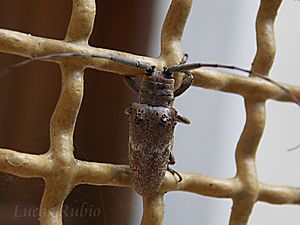Oncideres ulcerosa facts for kids
Quick facts for kids Oncideres ulcerosa |
|
|---|---|
 |
|
| Scientific classification |
Oncideres ulcerosa is a fascinating type of beetle that belongs to the Cerambycidae family, also known as longhorn beetles. These beetles are famous for their very long antennae, which can sometimes be even longer than their bodies! This particular species was first described by a scientist named Ernst Friedrich Germar in 1824. You can find Oncideres ulcerosa living in parts of South America, specifically in Paraguay and Brazil.
Contents
What is Oncideres ulcerosa?
Oncideres ulcerosa is a species of longhorn beetle. Longhorn beetles get their name because their antennae are often very long, looking a bit like horns. These antennae are important for the beetle to feel its way around and find food or mates. Most longhorn beetles are herbivores, meaning they eat plants. They often feed on wood, either as larvae or as adults.
Where Do They Live?
This beetle species is native to South America. It has been found in two countries:
These areas have warm climates and plenty of trees, which are perfect for beetles that feed on wood.
What Do They Look Like?
Like other longhorn beetles, Oncideres ulcerosa has a hard outer shell, called an exoskeleton, which protects its body. They also have six legs and two pairs of wings, though the front pair (called elytra) are hard and protect the delicate flying wings underneath. The exact colors and patterns can vary, but many longhorn beetles have camouflage to help them blend in with tree bark.
Life Cycle of the Beetle
Like all insects, Oncideres ulcerosa goes through a complete metamorphosis. This means it changes a lot during its life, passing through four main stages: egg, larva, pupa, and adult.
Egg Stage
The life cycle begins when an adult female beetle lays her tiny eggs. She often lays them in cracks or under the bark of trees. This protects the eggs and provides a food source for the young larvae when they hatch.
Larva Stage
Once the eggs hatch, tiny larvae emerge. These larvae are often called "grubs" and look like small, pale worms. They spend most of their time boring into the wood of trees, eating and growing. This stage is very important for the beetle's development, as the larvae store up energy they will need later.
Pupa Stage
After growing enough, the larva changes into a pupa. The pupa stage is a resting period where the larva transforms into an adult beetle. During this time, the pupa does not eat or move much. It is a time of amazing change inside its body.
Adult Stage
Finally, the adult beetle emerges from the pupa. The adult Oncideres ulcerosa is now ready to find a mate and continue the life cycle by laying its own eggs. Adult beetles usually live for a shorter time compared to the larval stage. Their main job is to reproduce.
Why Are Beetles Important?
Beetles, including Oncideres ulcerosa, play many important roles in nature.
- Decomposers: Many beetles help break down dead wood and other plant material. This returns nutrients to the soil, which helps new plants grow.
- Food Source: Beetles are a food source for many other animals, like birds, reptiles, and small mammals.
- Pollinators: Some beetles help pollinate flowers, just like bees and butterflies do.
See also

- In Spanish: Oncideres ulcerosa para niños

